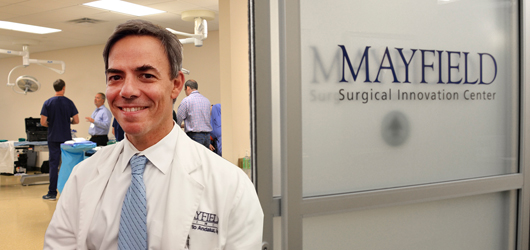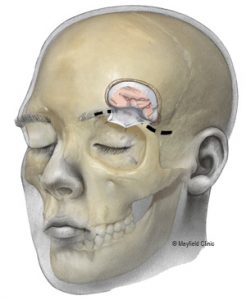
Norberto Andaluz, MD, a Mayfield neurosurgeon and skull base specialist, has been using the eye as a surgical corridor to the brain for nearly 15 years. Dr. Andaluz is an expert in the “supraorbital” keyhole approach, the type of minimally invasive brain surgery that was used to remove a blood clot recently during treatment of U.S. Senator John McCain.
Dr. Andaluz has performed orbital-approach procedures more than 100 times during his career. His first publication about the supraorbital procedure in a peer-reviewed journal appeared 14 years ago. Of the 63 journal articles that he has co-authored, 9 involve the evolution of the orbital approach in neurosurgery.
Surgeons use the supraorbital approach in the treatment of brain aneurysms, benign and cancerous tumors, cysts, and some blood clots. In the case of a blood clot, the orbital route can provide an opening for a small catheter, which can be used to suction out the clot.
 The supraorbital keyhole approach involves making a curved incision over the eyebrow, gently pulling back a flap of skin, and then opening the skull above the eye in a craniotomy about the size of a 50-cent piece. The procedure evolved from a two-part approach, which involved two incisions and a more difficult cosmetic repair.
The supraorbital keyhole approach involves making a curved incision over the eyebrow, gently pulling back a flap of skin, and then opening the skull above the eye in a craniotomy about the size of a 50-cent piece. The procedure evolved from a two-part approach, which involved two incisions and a more difficult cosmetic repair.
“An eyebrow incision is a straightforward way of getting into the target,” Dr. Andaluz says. “If the lesion is in the front of the brain, we have easy access through this portal.”
Dr. Andaluz can also make the incision at the top of the eyelid, a modification of the supraorbital keyhole approach called a mini-supraorbital craniotomy.
The two procedures are efficient, allowing quick access to the lesion. “In addition, you don’t have to disturb the temporalis muscle, a chewing muscle, which means that people don’t have jaw pain afterwards,” Dr. Andaluz says. “There is minimal disruption and exposure of brain, so there is a reduced chance of complications. And there is an excellent post-operative cosmetic result.”
Recovery time from an eyebrow or eyelid incision is rapid. Following Sen. McCain’s surgery, Dr. Andaluz told Agence France-Presse (AFP), the international wire service, that, “We have CEOs of companies who have had [this] surgery who have made executive decisions from the ICU bed.”
Meanwhile, scars from the incisions virtually vanish into the lines of the eyebrow or eyelid.
Nevertheless, some patients, especially women, still prefer a larger, curved incision behind the hairline, Dr. Andaluz says.
Complete recovery, of course, will always depend on the reason for surgery. Sen. McCain was diagnosed with glioblastoma multiforme, an aggressive brain cancer that may require further treatment with radiation and chemotherapy.
In August Dr. Andaluz will travel to Louisville, Kentucky, and then on to China to lecture and teach other neurosurgeons how to perform the supraorbital approach to the brain.
— Cindy Starr